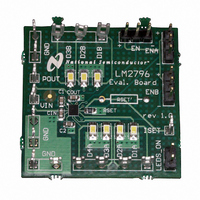LM2796TLEV National Semiconductor, LM2796TLEV Datasheet - Page 7

LM2796TLEV
Manufacturer Part Number
LM2796TLEV
Description
BOARD EVALUATION LM2796TL
Manufacturer
National Semiconductor
Series
PowerWise®r
Specifications of LM2796TLEV
Current - Output / Channel
20mA
Outputs And Type
7, Non-Isolated
Voltage - Output
4 V
Features
Charge Pump
Voltage - Input
2.7 ~ 5.5V
Utilized Ic / Part
LM2796
Lead Free Status / RoHS Status
Not applicable / Not applicable
Circuit Description
LED outputs rise at the rate of the reference voltage ramp.
Due to the soft-start circuitry, turn-on time of the LM2796 is
approximately 100µs (typ.).
Thermal Protection
Internal thermal protection circuitry disables the LM2796
when the junction temperature exceeds 160˚C (typ.). This
feature protects the device from being damaged by high die
temperatures that might otherwise result from excessive
power dissipation. The device will recover and operate nor-
mally when the junction temperature falls below 120˚C (typ.).
It is important that the board layout provides good thermal
conduction. This will help to keep the junction temperature
within specified operating ratings.
Applications Information
ADJUSTING LED BRIGHTNESS (PWM control)
Perceived LED brightness can be adjusted using a PWM
control signal to turn the LM2796 current sources ON and
OFF at a rate faster than perceptible by the eye. When this
is done, the total brightness perceived is proportional to the
duty cycle (D) of the PWM signal (D = the percentage of time
that the LED is on in every PWM cycle). A simple example: if
the LEDs are driven at 15mA each with a PWM signal that
has a 50% duty cycle, perceived LED brightness will be
about half as bright as compared to when the LEDs are
driven continuously with 15mA. A PWM signal thus provides
brightness (dimming) control for the solution.
The minimum recommended PWM frequency is 100Hz. Fre-
quencies below this may be visibly noticeable as flicker or
blinking. The maximum recommended PWM frequency is
1kHz. Frequencies above this may cause interference with
internal current driver circuitry.
The preferred method for applying a PWM signal to adjust
brightness is to keep the master EN voltage ON continuously
and to apply the PWM signal(s) to the current source enable
pin(s): ENA and/or ENB. The benefit of this type of connec-
tion can be best understood with a contrary example. When
a PWM signal is connected to the master enable (EN) pin,
the charge pump repeatedly turns on and off. Every time the
charge pump turns on, there is an inrush of current as
capacitances, both internal and external, are recharged. This
inrush current results in a current and voltage spike at the
input of the part. By only applying the PWM signal to ENA/
ENB, the charge pump stays on continuously and much
lower input noise results.
(Continued)
7
In cases where a PWM signal must be connected to the EN
pin, measures can be taken to reduce the magnitude of the
charge-pump turn-on voltage spikes. More input capaci-
tance, series resistors and/or ferrite beads may provide ben-
efits.
If the current and voltage spikes can be tolerated, connect-
ing the PWM signal to the EN pin does provide a benefit:
lower supply current when the PWM signal is active. When
the PWM signal is low, the LM2796 will be shutdown and
input current will only be a few micro-amps. This results in a
lower time-averaged input current than the prior suggestion,
where EN is kept on continuously.
CAPACITOR SELECTION
The LM2796 requires 4 external capacitors for proper opera-
tion. Surface-mount multi-layer ceramic capacitors are rec-
ommended. These capacitors are small, inexpensive and
have very low equivalent series resistance (ESR
typ.). Tantalum capacitors, OS-CON capacitors, and alumi-
num electrolytic capacitors are not recommended for use
with the LM2796 due to their high ESR, as compared to
ceramic capacitors.
For most applications, ceramic capacitors with X7R or X5R
temperature characteristic are preferred for use with the
LM2796. These capacitors have tight capacitance tolerance
(as good as
(X7R:
85˚C).
Capacitors with Y5V or Z5U temperature characteristic are
generally not recommended for use with the LM2796. Ca-
pacitors with these temperature characteristics typically
have wide capacitance tolerance (+80%, -20%) and vary
significantly over temperature (Y5V: +22%, -82% over -30˚C
to +85˚C range; Z5U: +22%, -56% over +10˚C to +85˚C
range). Under some conditions, a nominal 1µF Y5V or Z5U
capacitor could have a capacitance of only 0.1µF. Such
detrimental deviation is likely to cause Y5V and Z5U capaci-
tors to fail to meet the minimum capacitance requirements of
the LM2796.
The minimum recommended voltage rating for these capaci-
tors is 10V.
MICRO SMD MOUNTING
The LM2796 is an 18-bump micro SMD with a bump size of
approximately 300 micron diameter. The micro SMD pack-
age requires specific mounting techniques detailed in Na-
tional Semiconductor Application Note 1112 (AN-1112).
±
15% over -55˚C to 125˚C; X5R:
±
10%) and hold their value over temperature
±
15% over -55˚C to
www.national.com
<
20mW








